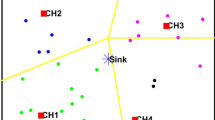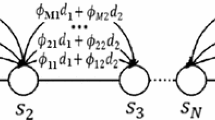Abstract
Nowadays, wireless sensor networks (WSNs) have found many applications in a variety of topics. The main objective in WSNs is to measure environmental phenomena and send reading data to the sink in multi-hop paths. The most important challenge in WSNs is to minimize energy consumption in the sensor nodes and increase the network lifetime. One of the most effective techniques for reducing energy consumption in WSNs is the compressive sensing (CS) which has recently been considered by the researchers. CS reduces the network energy consumption by reducing the number and size of transmitted data packets over the network. On the other hand, in order to overcome the challenge of energy consumption in the network, it is necessary to identify and analyze the energy consumption resources of the network. Although many models have been proposed for energy consumption analysis in the WSN, but these models were not based on the CS technique. Therefore, we have proposed a complete model in this work for energy consumption analysis in various CS-based data gathering techniques in WSNs. This model can be very effective in energy consumption optimization when designing a CS-based data gathering technique for WSN.

































Similar content being viewed by others
Explore related subjects
Discover the latest articles, news and stories from top researchers in related subjects.References
Akyildiz, I. F., Su, W., Sankarasubramaniam, Y., & Cayirci, E. (2002). Wireless sensor networks: A survey. Computer Networks, 38(14), 393–422.
Xiong, Z., Liveris, A., & Cheng, S. (2004). Distributed source coding for sensor networks. IEEE Signal Processing Magazine, 21(5), 80–94.
Lee, J., & Cheng, W. (2012). Fuzzy-logic-based clustering approach for wireless sensor networks using energy predication. IEEE Sensors Journal, 12(9), 2891–2897.
Zahhad, M. A., Amin, O., Farrag, M., & Ali, A. (2015). An energy consumption model for wireless sensor networks. In IEEE 5th international conference on energy aware computing systems & applications, Egypt, March 2015.
Haupt, J., Bajwa, W., Rabbat, M., & Nowak, R. (2008). Compressed sensing for networked data. Signal Processing Magazine, 25(2), 92–101.
Mahmudimanesh, M., Khelil, A., & Suri, N. (2012). Balanced spatio-temporal compressive sensing for multi-hop wireless sensornetworks. In Proceedings of the IEEE 9th international conference on mobile ad hoc and sensor systems, USA, Oct. 2012.
Qin, Z., Fan, J., Liu, Y., Gao, Y., & Li, G. Y. (2018). Sparse representation for wireless communications: A compressive sensing approach. IEEE Signal Processing Magazine, 35(3), 40–58.
Quan, L., Xiao, S., Xue, X., & Lu, C. (2016). Neighbor-aided spatial-temporal compressive data gathering in wireless sensor networks. IEEE Communication Letters, 14(3), 578–581.
Candes, E., & Wakin, M. (2008). An introduction to compressive sampling. Signal Processing Magazine, 25(2), 21–30.
Wakin, M. B., Duarte, M. F., Sarvotham, S., Baron, D., & Baraniuk, R. G. (2009). Recovery of jointly sparse signals from few random. In Proceedings of the 15th ACM MobiCom, Beijing, China (pp. 145–156).
Tropp, J., & Gilbert, A. (2007). Signal recovery from random measurements via orthogonal matching pursuit. IEEE Transactions on Information Theory, 53(12), 4655–4666.
Kulkarni, A., & Mohsenin, T. (2017). Low overhead architectures for OMP compressive sensing reconstruction algorithm. IEEE Transactions on Circuits and Systems, 64(6), 1468–1480.
Donoho, D. L., Elad, M., & Temlyakov, V. N. (2006). Stable recovery of sparse over complete representations in the presence of noise. IEEE Transactions on Information Theory, 52(1), 6–18.
Yadav, S., & Kumar, V. (2019). Hybrid compressive sensing enabled energy efficient transmission of multi-hop clustered UWSNs. International Journal of Electronics and Communications (AEÜ), 110, 1–10.
Candes, E., & Romberg, J. (2007). Sparsity and incoherence in compressive sampling. Inverse Problems, 23(3), 969–985.
Mehrjoo, S., & Khunjush, F. (2018). Accurate compressive data gathering in wireless sensor networks using weighted spatio-temporal compressive sensing. Telecommunication Systems, 68(1), 79–88.
Ali, B., Pissinou, N., & Makki, K. (2009). Identification and validation of spatio-temporal associations in wireless sensor networks. In Proceedings of the SENSORCOMM, Athens, Greece, Jun. 2009 (pp. 496–501).
Tayeh, G. B., Makhoul, A., Perera, C., & Demerjian, J. (2019). A spatial-temporal correlation approach for data reduction in cluster-based sensor networks. IEEE Access, 7, 50669–50680.
Cai, W., & Zhang, M. (2018). Spatio-temporal correlation–based adaptive sampling algorithm for clustered wireless sensor networks. International Journal of Distributed Sensor Networks, 14(8), 1–14.
Jiang, D., Nie, L., Lv, Z., & Song, H. (2016). Spatio-temporal Kronecker compressive sensing for traffic matrix recovery. IEEE Access: Practical Innovations, Open Solutions, 4, 3046–3053.
Gong, B., Cheng, P., Chen, Z., Liu, N., Gui, L., & de Hoog, F. (2015). Spatio-temporal compressive network coding for energy-efficient distributed data storage in wireless sensor networks. IEEE Communication Letters, 19(5), 803–806.
Leinonen, M., & Member, S. (2015). Sequential compressed sensing with progressive signal reconstruction in wireless sensor networks. IEEE Transactions on Wireless Communication, 14(3), 1622–1635.
Duarte, M., & Baraniuk, R. (2010). Kronecker product matrices for compressive sensing. In Proceedings of the IEEE international conference on acoustics, speech, and signal processing, Dallas, TX, USA (pp. 3650–3653).
Haque, M., Ahmad, A.,&Imran, M. (2017). Review of hierarchical routing protocols for wireless sensor networks. In Proceedings of the intelligent communication and computational technologies (pp. 237–246).
Shafiq, M., Ashraf, H., Ullah, A., & Tahira, S. (2020). Systematic literature review on energy efficient routing schemes in WSN: A survey. Mobile Networks and Applications, 25(1), 882–895.
Chan, L., Chavez, K. G., Rudolph, H., & Hourani, A. (2020). Hierarchical routing protocols for wireless sensor network: A compressive survey. Wireless Networks, 26(1), 3291–3314.
Purkait, R., & Tripathi, S. (2016). Energy aware fuzzy based multi-hop routing protocol using unequal clustering. Wireless Personal Communications, 94, 809–833.
Lan, K. C., & Wei, M. Z. (2017). A compressibility-based clustering algorithm for hierarchical compressive data gathering. IEEE Sensors Journal, 17(8), 2550–2562.
Luo, C., et al. (2009). Compressive data gathering for large-scale wireless sensor networks. In Proceedings of the 15th annual international conference on mobile computing and networking (Mobicom) (pp. 145–156).
Xie, R., & Jia, X. (2014). Transmission-efficient clustering method for wireless sensor networks using compressive sensing. IEEE Transactions on Parallel and Distributed Systems, 25(3), 806–815.
Xu, X., Ansari, R., Khokhar, A., & Vacilacos, A. V. (2015). Hierarchical data aggregation using compressive sensing (HDACS) in WSNs. ACM Transactions on Sensor Networks, 11(3), 1–25.
Majma, M. R., Pedram, H., & Dehghan, M. (2014). IGBDD: Intelligent grid based data dissemination protocol for mobile sink in wireless sensor networks. Wireless Personal Communications, 78(1), 687–714.
Soni, V., & Mallick, D. K. (2017). FTGAF-HEX: Fuzzy logic based two level geographic routing protocol in wireless sensor networks. Microsystem Technology, 23(8), 3443–3455.
Ghaderi, M. R., Tabataba Vakili, V., & Sheikhan, M. (2020). FGAF-CDG: Fuzzy geographic routing protocol based on compressive data gathering in wireless sensor networks. Journal of Ambient Intelligence and Humanized Computing, 11(3), 2567–2589.
Pacharaney, U. S., & Gupta, R. K. (2019). Clustering and compressive data gathering in wireless sensor network. Wireless Personal Communications, 109, 1311–1331.
Abo-Zahhad, M., Amin, O., Farrag, M., & Ali, A. (2014). Survey on energy consumption models in wireless sensor networks. Open Transactions on Wireless Communications, 1(1), 63–79.
Karakus, C., Gurbuz, A. C., & Tavli, B. (2013). Analysis of energy efficiency of compressive sensing in wireless sensor networks. IEEE Sensors Journal, 13(5), 1999–2008.
Luo, J., Xiang, L., & Rosenberg, C. (2010). Does compressed sensing improve the throughput of wireless sensor networks? In Proceeding of the IEEE international conference on communications, Cape Town, South Africa.
Ali, A., Abo-Zahhad, M., & Farrag, M. (2017). Modeling of wireless sensor networks with minimum energy consumption. Arabian Journal for Science and Engineering, 42(7), 2631–2639.
Zhou, C., Wang, M., Qu, W., & Lu, Z. (2018). A wireless sensor network model considering energy consumption balance. Mathematical Problems in Engineering, 2018, 1–8. https://doi.org/10.1155/2018/8592821.
Cui, S., Cao, Y., Sun, G., & Bin, S. (2018). A new energy-aware wireless sensor network evolution model based on complex network. EURASIP Journal on Wireless Communications and Networking, 2018, 1–8. https://doi.org/10.1186/s13638-018-1240-0.
Zhu, L., Ci, B., Liu, Y., & Chen, Z. (2015). Data gathering in wireless sensor networks based on reshuffling cluster compressed sensing. International Journal of Distributed Sensor Networks, 11, 11. https://doi.org/10.1155/2015/260913.
Heinzelman, W., Chandrakasan, A., & Balakrishnan, H. (2002). An application- specific protocol architecture for wireless microsensor networks. IEEE Transactions on Wireless Communications, 1(4), 660–670.
Liu, X., & Wu, J. (2020). A method for energy balance and data transmission optimal routing in wireless sensor networks. Sensors (Basel). https://doi.org/10.3390/s19133017.
Valle-Soto, C. D., Mex-Perera, C., Nolazco-Flores, J. A., Velázquez, R., & Rossa-Sierra, A. (2020). Wireless sensor network energy model and its use in the optimization of routing protocols. Sensors, 13(3), 1–33.
Vales-Alonso, J., Egea-Lopez, E., Martínez-Sala, A., Pavon-Marino, P., Bueno-Delgado, M. V., & García-Haro, J. (2007). Performance evaluation of MAC transmission power control in wireless sensor networks. Computer Networks, 51(6), 1483–1498.
Djiroun, F. Z., & Djenouri, D. (2017). MAC protocols with wake-up radio for wireless sensor networks: A review. IEEE Communications Surveys & Tutorials, 19(1), 587–618.
Rasul, A., & Erlebach, T. (2014). Reducing idle listening during data collection in wireless sensor networks. In Proceedings of the 10th international conference on mobile ad-hoc and sensor networks, Maui, HI, USA.
Minh, N. N., & Kim, M. K. (2016). Reducing idle listening time in pipeline-forwarding MAC protocols of wireless sensor networks. In Proceedings of the IEEE international conference on advanced technologies for communications (ATC), Hanoi, Vietnam.
Lee, S. H., & Choi, L. (2017). Zero MAC: Toward a zero sleep delay and zero idle listening media access control protocol with ultralow power radio frequency wakeup sensor. International Journal of Distributed Sensor Networks, 13(8), 1–21.
Author information
Authors and Affiliations
Corresponding author
Additional information
Publisher's Note
Springer Nature remains neutral with regard to jurisdictional claims in published maps and institutional affiliations.
Rights and permissions
About this article
Cite this article
Ghaderi, M.R., Tabataba Vakili, V. & Sheikhan, M. Compressive sensing-based energy consumption model for data gathering techniques in wireless sensor networks. Telecommun Syst 77, 83–108 (2021). https://doi.org/10.1007/s11235-020-00748-9
Received:
Revised:
Accepted:
Published:
Issue Date:
DOI: https://doi.org/10.1007/s11235-020-00748-9




